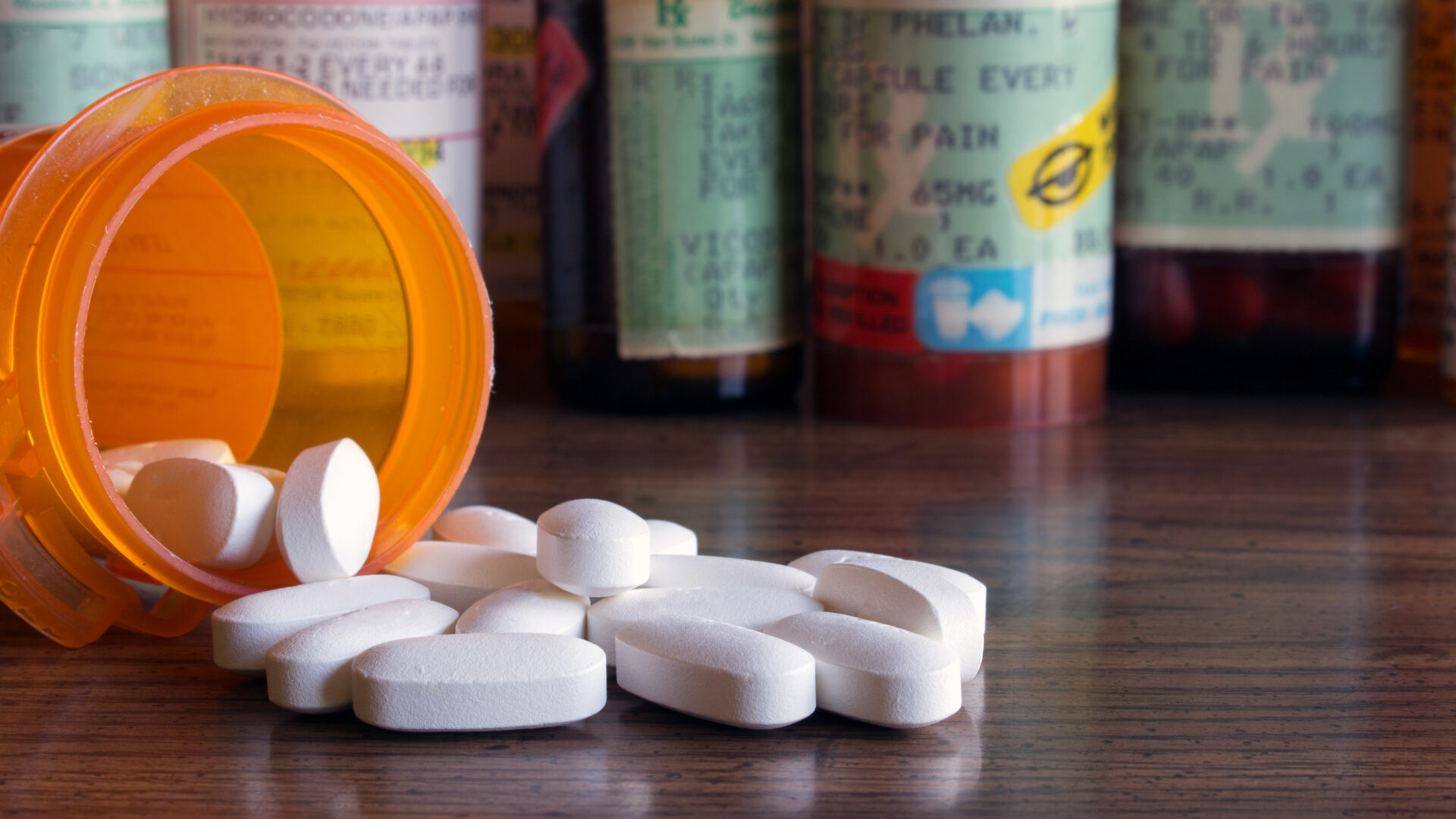Opioids encompass a broad category of substances that includes both prescription pain medications and illegal drugs. These powerful substances affect both the body and brain, with research increasingly revealing how opioids impact mental health through complex interactions with brain chemistry, emotional regulation, and behavior patterns.
Although opioid misuse can lead to addiction, effective treatments are available, and recovery is possible with proper support and care.

What are Opioids?
Opioids are powerful substances that interact with opioid receptors in the body and brain. While healthcare providers prescribe opioids to manage pain, these substances are frequently misused for their ability to create intense feelings of pleasure and well-being. These euphoric effects can lead some people to take prescription opioids in ways other than prescribed or to seek out illegal forms of these drugs.
While myriad types of opioids exist, they can be divided into three main categories: natural, semi-synthetic, and synthetic. Natural opioids (e.g., Morphine and Codeine) are derived directly from the opium poppy plant. Semi-synthetic opioids (e.g., Hydrocodone, Oxycodone, and Heroin) are created in laboratories using natural opiates as a starting point. Synthetic opioids (Fentanyl, for example) are entirely human-made chemicals that contain no natural ingredients [1].
It’s important to note that the terms “opioids” and “opiates” are not synonymous. The distinction lies in their origin:
- Opiates specifically refer to natural opioids
- Opioids encompass all substances that act on the body’s opioid receptors, whether natural, semi-synthetic, or synthetic. In effect, an opiate is a type of opioid.
Opioid Action and Effects
To produce effects, opioids attach to specific proteins called opioid receptors, which are found throughout the body but are particularly concentrated in areas of the brain that control pain and pleasure [2]. When these drugs bind to their receptors, they trigger a cascade of chemical changes that block pain signals and release large amounts of dopamine, the brain’s “feel-good” chemical [1].
This flood of dopamine not only relieves pain but also produces side effects such as intense feelings of relaxation and bliss. Due to their ability to produce a sense of euphoria, opioids are often misused.
Even when prescribed, opioid use can lead to negative health effects such as drowsiness, confusion, nausea, and constipation. They can also impair the immune system, and can potentially cause cardiovascular changes (e.g., low blood pressure and cardiac arrest) depending on the dose and duration of use. At high doses, opioids can cause slow shallow breathing, unconsciousness, and potentially life-threatening respiratory depression [1].
Additionally, repeated use of opioids, including prescription opioids, can lead to tolerance, requiring higher doses to achieve the same effect. Ultimately, continued opioid use can result in dependence and addiction [1].
Illicit and Prescription Opioids
All opioids affect the body in similar ways but with different degrees of impact, meaning the safety of these substances can vary dramatically based on their source. Illicit opioids are substances manufactured, distributed, or sold illegally. These drugs often contain unknown ingredients and varying potency levels, making them particularly dangerous.
Common Illicit Opioids Include:
- Heroin
- Illegally manufactured fentanyl and fentanyl analogs
- Counterfeit prescription pills containing fentanyl
- Opium
- Diverted prescription medications sold illegally
Prescription opioids, in contrast, are medications legally prescribed by healthcare providers to manage moderate to severe pain. These medications are carefully manufactured under controlled conditions with known potency and ingredients.
However, they still carry the risks of misuse, addiction, and overdose. Even prescription opioids like tramadol require careful monitoring and specialized treatment protocols.
Common Prescription Opioids Include:
- Hydrocodone (Vicodin, Norco)
- Oxycodone (OxyContin, Percocet)
- Oxymorphone (Opana)
- Morphine (MS Contin, Kadian)
- Codeine
- Fentanyl (Duragesic, Actiq)
- Methadone
- Tramadol
Note, however, that many prescription opioids are illegally distributed. Additionally, many substances are illegally manufactured and sold under the guise of prescription painkillers. These illegally distributed opioids are mixed with a host of substances, producing combinations and dosage levels that can be fatal.
Opioid Overdose
An opioid overdose occurs when these drugs overwhelm the body’s systems by flooding opioid receptor sites in the brain. Opioid overdose can lead to severe respiratory depression and death [1]. In fact, according to overdose data from the Centers for Disease Control and Prevention, more than 81,000 people died from an opioid-involved overdose in 2023 [3].
Fentanyl, a synthetic opioid that is 50 to 100 times more potent than morphine, has become particularly concerning in the opioid overdose crisis. Even tiny amounts of this substance can cause a fatal overdose, and it’s increasingly found in counterfeit pills or mixed with other drugs [4]. As such, many individuals who overdose on fentanyl don’t even realize they’ve taken the substance.
Polysubstance use, which involves taking two or more substances within a short period of time, significantly increases overdose risk. When combined with alcohol, benzodiazepines, or other central nervous system depressants, opioids can cause dangerous respiratory depression.
These combinations can be lethal even when each substance is taken in amounts that would typically be safe on their own. Mixing multiple painkillers or combining them with other substances is associated with a particularly high risk of overdose.
Naloxone, an opioid antagonist medication, can rapidly reverse an opioid overdose and prevent death when administered quickly. This life-saving medication is increasingly available to the public, and many communities now provide training on how to recognize and respond to overdose situations.
Opioid Addiction
As a type of substance use disorder, opioid addiction is a chronic, relapsing medical condition characterized by compulsive drug seeking and use despite negative consequences. Opioid use disorder can develop from either prescription or illicit opioid abuse, and it often stems from legitimate pain-management needs.
To help clinicians diagnose opioid use disorders, the Diagnostic and Statistical Manual of Mental Disorders, Fifth Edition (DSM-5) uses an 11-point checklist. Diagnosis can be established if an individual meets at least two of those criteria within a 12-month period. Some of these diagnostic criteria include [5]:
- Taking larger amounts or using opioids for a longer duration than intended
- Being unable to control use despite a persistent desire to do so
- Experiencing cravings and spending significant time obtaining, using, or recovering from opioids
- Giving up important activities and failing to fulfill major obligations at work, school, or home due to use
- Continuing use despite persistent social or interpersonal problems because of use
- Using opioids in physically hazardous situations
- Continuing use despite physical or psychological problems
- Developing tolerance and experiencing withdrawal symptoms
Data from the 2023 National Survey on Drug Use and Health (NSDUH) reveals the widespread impact of opioid addiction in the United States. In 2023, approximately 8.6 million people aged 12 and older reported misusing prescription pain relievers, and an estimated 5.7 million people in this same age group met the criteria for an opioid use disorder [6].
Opioid Withdrawal
Chronic opioid use can lead to physical dependence, which is when the body has adapted to the ongoing presence of the substance and now needs it to function normally. When someone has become dependent on the substance and then reduces or stops their opioid use, they may experience withdrawal, a potentially dangerous cluster of symptoms that can begin within hours of the last dose.
Some of the first signs of opioid withdrawal include anxiety, aches, restlessness, irritability, and an increased sensitivity to pain [5]. Additional signs of opioid withdrawal include [5]:
- Feelings of unease
- Nausea, vomiting, diarrhea, yawning
- Watery eyes, runny nose
- Dilated pupils
- Increased sweating, goosebumps
- Fever
- Insomnia
The speed and severity of opioid withdrawal symptoms are dependent on the specific substance of use and various personal factors and characteristics. With some substances, withdrawal symptoms can begin six to 12 hours after the last dose. With others, symptoms can take two to four days to emerge [5].
How Opioids Impact Mental Health
Opioids profoundly affect mental health by altering brain chemistry and emotional regulation systems. These substances impact not only the brain’s pain and pleasure pathways but also circuits involved in mood, thinking, and behavior. Over time, these changes can impact mental health conditions, creating complex challenges for both treatment and recovery.
Treating mental illness in opioid users requires an understanding of the intricate relationship between substance use and psychological well-being. Many individuals experience depression, anxiety, or post-traumatic stress disorder alongside their opioid use [7].
In fact, this combination of substance use and mental health disorders, known as co-occurring disorders or dual diagnosis, is quite common. According to the 2023 NSDUH, among the 58.7 million adults with a mental illness, 20.4 million people (roughly one-third) also had a substance use disorder [6].
When it comes to treating opioid use disorders alongside mental health concerns, research demonstrates that addressing both conditions simultaneously yields the best outcomes. When treatment focuses solely on either mental health or substance use while neglecting the other disorder, individuals face increased risks of relapse and poorer overall outcomes [8].
Opioid Use Disorder Treatment
Treatment for opioid use disorder typically involves a comprehensive approach combining medications, behavioral therapies, and support services. The journey often begins with medically supervised detoxification, where healthcare providers help safely manage withdrawal symptoms. However, detox alone is rarely sufficient for long-term recovery. Rather it serves as the first step in a more comprehensive treatment plan.
Following detox, many individuals progress to inpatient care, which provides 24-hour monitoring and treatment in a structured environment. One step down from residential treatment is a partial hospitalization program (PHP), which provides intensive care multiple hours per day most days of the week. However, with a PHP, individuals live at home or in a sober living environment.
Another step down from a PHP is an intensive outpatient program (IOP). Offering comprehensive treatment, an IOP allows individuals to live at home or in a sober living environment while also maintaining some daily responsibilities and activities.
Regardless of the level of care, medication-assisted treatment (MAT) plays a crucial role in opioid use disorder recovery for many people. FDA-approved medications such as methadone, buprenorphine, and naltrexone help reduce cravings, prevent withdrawal symptoms, normalize brain chemistry, and block the euphoric effects of illicit opioids.
When combined with counseling and behavioral therapies, MAT can improve the chances of successful recovery and reduce the risk of overdose.
Recovery is Possible
Scientific advances in addiction medicine have revolutionized treatment for opioid use disorder, creating multiple pathways to recovery. Today’s programs combine medical expertise with psychological support, while expanding access to medication-assisted treatment continues to improve outcomes.
In addition, healthcare providers now offer sophisticated combinations of interventions tailored to individual needs, from medical detoxification to long-term maintenance therapy.
These evidence-based approaches address both the physical and psychological aspects of addiction, and they feature entire networks of healthcare professionals, counselors, and peer support specialists.
Through comprehensive treatment programs that integrate behavioral therapy, medication management, and ongoing support services, thousands of individuals are finding their way to lasting recovery. In fact, recovery is not just possible; it happens every day.
- National Institute on Drug Abuse. (2024 November). Opioids. National Institute on Drug Abuse. https://nida.nih.gov/research-topics/opioids. Accessed 16 April 2025.
- National Institutes of Health. (2018 May 22). How opioid drugs activate receptors. National Institutes of Health. https://www.nih.gov/news-events/nih-research-matters/how-opioid-drugs-activate-receptors. Accessed 16 April 2025.
- Centers for Disease Control and Prevention. (2024 May 15). U.S. overdose deaths decrease in 2023, first time since 2018. Centers for Disease Control and Prevention. https://www.cdc.gov/nchs/pressroom/nchs_press_releases/2024/20240515.htm. Accessed 16 April 2025.
- Centers for Disease Control and Prevention. (2024 October 30). Fentanyl. https://www.cdc.gov/overdose-prevention/about/fentanyl.html. Accessed 16 April 2025.
- American Psychiatric Association. (2013). Diagnostic and statistical manual of mental disorders (5th ed.). https://doi.org/10.1176/appi.books.9780890425596. Accessed 16 April 2025.
- Substance Abuse and Mental Health Services Administration. (2024). Key Substance Use and Mental Health Indicators in the United States: Results from the 2023 National Survey on Drug Use and Health. Substance Abuse and Mental Health Services Administration. https://www.samhsa.gov/data/sites/default/files/reports/rpt47095/National%20Report/National%20Report/2023-nsduh-annual-national.pdf. Accessed 16 April 2025.
- National Institute on Drug Abuse. (2024 September). Co-occurring disorders and health conditions. National Institute on Drug Abuse. https://nida.nih.gov/research-topics/co-occurring-disorders-health-conditions#health-conditions. Accessed 16 April 2025.
- Substance Abuse and Mental Health Services Administration. (2024). Co-occurring mental health and substance use. Publication No. PEP24-01-008. Substance Abuse and Mental Health Services Administration. https://www.samhsa.gov/mental-health/what-is-mental-health/conditions/co-occurring-disorders. Accessed 16 April 2025.
The Clinical Affairs Team at MentalHealth.com is a dedicated group of medical professionals with diverse and extensive clinical experience. They actively contribute to the development of content, products, and services, and meticulously review all medical material before publication to ensure accuracy and alignment with current research and conversations in mental health. For more information, please visit the Editorial Policy.
MentalHealth.com is a health technology company guiding people towards self-understanding and connection. The platform provides reliable resources, accessible services, and nurturing communities. Its purpose is to educate, support, and empower people in their pursuit of well-being.
Linda Armstrong is an award-winning writer and editor with over 20 years of experience across print and digital media.
Shivani Kharod, Ph.D. is a medical reviewer with over 10 years of experience in delivering scientifically accurate health content.
The Clinical Affairs Team at MentalHealth.com is a dedicated group of medical professionals with diverse and extensive clinical experience. They actively contribute to the development of content, products, and services, and meticulously review all medical material before publication to ensure accuracy and alignment with current research and conversations in mental health. For more information, please visit the Editorial Policy.
MentalHealth.com is a health technology company guiding people towards self-understanding and connection. The platform provides reliable resources, accessible services, and nurturing communities. Its purpose is to educate, support, and empower people in their pursuit of well-being.


